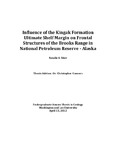Influence of the Kingak Formation Ultimate Shelf Margin on Frontal Structures of the Brooks Range in National Petroleum Reserve - Alaska (thesis)

View/
Author
Stier, Natalie Elizabeth
Subject
Washington and Lee University -- Honors in Geology
Paleopedology
Petroleum -- Prospecting
Alaska -- Brooks Range
Metadata
Show full item recordDescription
Thesis; [FULL-TEXT FREELY AVAILABLE ONLINE] Natalie Elizabeth Stier is a member of the Class of 2012 of Washington and Lee University. Well and seismic data in the National Petroleum Reserve in Alaska (NPRA) demonstrate that the Jurassic—Lower Cretaceous Kingak Shale is present throughout NPRA. Several southward progradational depositional sequences within the Kingak culminate in an ultimate shelf margin in southern NPRA, across which the formation thins dramatically. However the exact limit of the formation is obscured by frontal structures associated with Brooks Range tectonism.
These changes in Kingak facies and stratigraphic architecture are interpreted to have influenced the frontal structures of the Brooks Range foothills during Brookian thrusting and folding. The ultimate Kingak shelf margin is arcuate, reaching its most southern point in southwest NPRA. Here, this shelf margin controls an abrupt change in detachment level, stepping up from the top of Shublik Formation (Upper Triassic) to the top the Torok Formation (Aptian – Albian). The ramp in this area appears to be associated with the shelf margin because the Kingak is thicker in the footwall of the thrust system than in the hanging wall. This imbricate of repeated Kingak through Nanushuk Formation (Albian) underlies the Carbon Creek anticline. This prominent northwest-southeast trending fold marks a change in structural grain in the foothills region of southwestern NPRA from east-west trending anticlines to the south.
We propose that the abrupt change in structural grain is the result of northward verging thrust sheets impinging obliquely on the ultimate shelf margin of the Kingak in southwest NPRA. In southeast NPRA there is a more gradual thinning of the Kingak with the shelf margin lying farther to the north. Here the detachment at the top of the Shublik Formation gently rises to the top of the Kingak, and into the Torok Formation. Low-relief folds form over this
detachment, and involve Brookian strata, where the Carbon Creek anticline plunges to the southeast. Natalie E. Stier